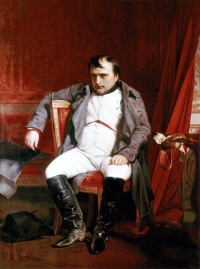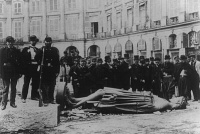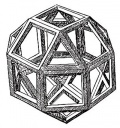Napoleon
From The Art and Popular Culture Encyclopedia

|
"Some people have thought that, in the eyes of Napoleon, religious belief was but a superstition consecrated by time, and that in re-establishing the Catholic religion he only made use of it as the tool of his ambition, without in any way considering the social influence of religion. Those who spoke thus were ignorant of the fact that Bonaparte was sincerely religious-I may add, a true Catholic. His detestation of the free-thinking cynicism which preaches contempt for religion-which was considered by him, on the contrary, as the basis of morality and decency--was as great as his horror for the bigotry which fetters human intelligence. "--Memoirs Illustrating the History of Napoleon I (1827) by Claude-François de Méneval "Napoleon was always glad to sleep in the beds of other kings, and establish himself in palaces, from which his appearance had driven them."--The Apocryphal Napoleon (1836) by Louis Geoffroy |
|
Related e |
|
Featured: |
Napoleon Bonaparte (1769 – 1821), was a military and political leader of France whose actions shaped European politics from 1804 to 1814.
Image
Napoleon has become a worldwide cultural icon who symbolises military genius and political power. Since his death, many towns, streets, ships, and even cartoon characters have been named after him. He has been portrayed in hundreds of films and discussed in hundreds of thousands of books and articles.
During the Napoleonic Wars he was taken seriously by the British press as a dangerous tyrant, poised to invade. A nursery rhyme warned children that Bonaparte ravenously ate naughty people; the 'bogeyman'. The British Tory press sometimes depicted Napoleon as much smaller than average height and this image persists. Confusion about his height also results from the difference between the French pouce and British inch—2.71 and 2.54 cm respectively; he was about 1.7 metres tall, average height for the period (see also Sade's appearance).
In 1908 psychologist Alfred Adler cited Napoleon to describe an inferiority complex in which short people adopt an overaggressive behavior to compensate for lack of height; this inspired the term Napoleon complex. The stock character of Napoleon is a comically short "petty tyrant" and this has become a cliché in popular culture. He is often portrayed wearing a comically large bicorne and a hand-in-waistcoat gesture—a reference to the 1812 painting by Jacques-Louis David.
Trivia
In 1801, Napoleon Bonaparte ordered the arrest of the anonymous author of Justine and Juliette
See also
- Napoleon's love life
- Mémoires autour de Napoléon I
- Le grand vainqueur: Anonymous caricature of Napoleon
- Napoleon in Caricature
- English Caricature and Satire on Napoleon I
- Code Napoleon
- Napoleon (2023 film)


